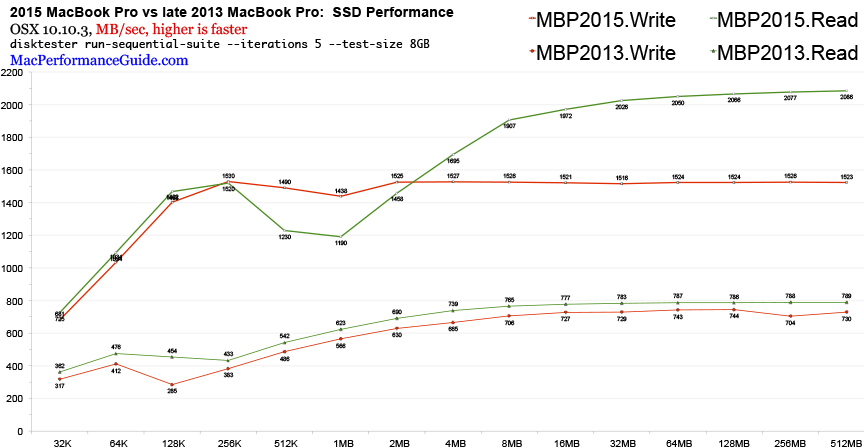
|

|

|

|

|

$220 SAVE $130 = 37.0% Western Digital 16.0TB Western Digital Ultrastar DC HC550 3.5-in… in Storage: Hard Drives
|

|

|

|

|
Internal Flash Drive / SSD Performance vs Late 2013 MacBook Pro

Authorized Apple dealer B&H Photo loaned MPG the Apple 15.4" MacBook Pro Retina (Mid 2015), 2.8GHz / Radeon R9 M370X / 16GB / 1TB, the configuration MPG recommends for power users, photographers, videographers, etc. Save money on AppleCare too.
The performance of the 2015 MacBook Pro with its 1TB flash drive sets a new standard among all Macs. The speed gains come by virtue of using the new SATA Express design; this is not something that can be had by upgrading a flash module in an older Mac.
The graph below shows performance for read and write for transfer sizes from 32K to 512MB. The results show that the flash drive in the 2015 MacBook Pro leaves the late 2013 MacBook Pro far behind (ditto for the 2013 Mac Pro). Moreover, this translates into huge gains in performance for some tasks where I/O is a big factor (see following pages of this review).
Some real-world considerations as to how much faster real work might go:
- Most applications operate in the 32K to 1MB transfer range, so the realistic real-world speeds are not likely to go beyond 1500 MB/sec.
- Real-world tasks are almost always a mix of computing and disk I/O (or “long” stretches of pure computing), not continuous I/O loads. Faster I/O may help little or not at all if the tasks being performed are in-memory and little I/O is done.
- The increased SSD speed can be largely masked by OS X caching. For non-continuous loads, this caching can mask any SSD speed differences.
- Most applications are not efficient enough to show more than marginal gains at real world tasks, i.e., twice as fast an SSD might mean 5-10% faster at a compute task. Or 1% or 2%. Even Photoshop benefits little beyond about 700MB/sec, due to inefficiencies.
Continues below.

disktester run-sequential-suite --iterations 5 --test-size 8GB
Git source code repository
As one real-world example, with the 'git' source code control system, testing shows that I/O speed for certain operations in a ~70GB repository hovers around 330 MB/sec for reads—far below the peak speeds seen in the graph. Similarly, 'git gc' ranges from 50 to 150 MB/sec for several minutes with all CPU cores going full tilt—the SSD is a marginal factor even for a huge repository.
But see the following pages for tests that show huge gains for the faster SSD in cases where I/O is a major factor.
Seagate 22TB IronWolf Pro 7200 rpm SATA III 3.5" Internal NAS HDD (CMR)
SAVE $100

 diglloydTools™
diglloydTools™

